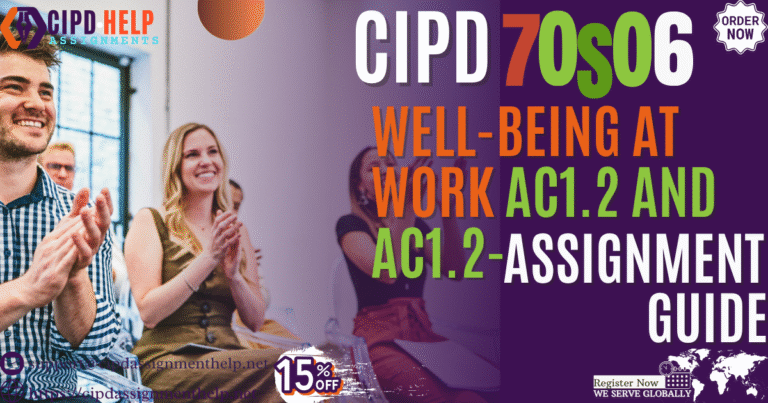CIPD Level 7OS06 Well-Being at Work AC1.3 and AC2.1 Guide
CIPD isn’t just theory for the shelf. It’s more like a mirror held up to what really happens in HR practice. Whether you’re dealing with AC1.3 or AC2.1, the questions go far beyond textbook answers. They’re about real teams, actual decisions, pressures, gaps, and those workplace dynamics we don’t always speak about openly. This CIPD Level 7OS06 Well-Being at Work AC1.3 and AC2.1 Guide isn’t claiming to be the definitive answer. It’s just a walkthrough.
A pointer. Something to help you think about how you might structure your response using realistic workplace examples. We tag these explanations to scenarios, nothing fancy, just honest case study-based reflections. Because, really, the way organisations approach well-being isn’t distinct or definitive. So take this guide as something you work with, not rely on. Blend it with academic material. Be cautious. Stay sharp.
AC1.3 Examine the responsibilities of organisations to engage with workplace well-being.
Now, “examine” doesn’t mean listing ideas or offering surface-level statements. It’s about digging in, looking at different angles, exploring how responsibilities show up in practice, and asking, “To what extent is this really being done, and why or why not?”
So you’re not just saying “Organisations have a responsibility to look after employees.” That’s too basic.
What you need to do is:
- Reflect on what those responsibilities actually are — legal, ethical, cultural, operational.
- Show how they play out in reality — both formally (through policy) and informally (through leadership, culture).
- Use your case study to illustrate. Inter Luxe Hotel Group gives plenty of scope here as our chosen example from HR policies to front-line practice.
- Let some thoughts contradict or trail off — it adds realism, and shows maturity of thinking.
Full Response AC1.3
When we talk about an organisation’s responsibilities around workplace well-being, it’s tempting to go straight to policies, risk assessments, mental health support, flexible working arrangements. Yes, those matter. But the responsibility runs deeper than accepting as is it. It’s about recognising that the workplace itself has a powerful influence over people’s lives, their mood, stress levels, relationships, even sleep.
At Inter Luxe Hotel Group, with 800 hotels in 25 countries, that responsibility can be difficult to manage consistently. A well-being policy written at head office in London may not feel relevant to a housekeeping supervisor in a coastal resort in Cornwall or a receptionist working night shifts in Leeds. Still, the organisation is expected to make sure that wherever someone works, there is a baseline of care, and ideally, a culture that goes further.
First, let’s talk about legal responsibility. In the UK, employers have a duty under the Health and Safety at Work Act (1974) to provide a safe working environment, which includes psychological safety, even if it’s not always enforced with the same urgency as physical hazards. That means Inter Luxe must identify potential risks to well-being, stress, harassment, unsafe hours, and do something about them. Not just once, but on an ongoing basis.
In practice? It varies.
In one Inter Luxe city hotel, a manager scheduled back-to-back shifts for night porters without proper rest periods. A grievance was raised after an employee fell asleep at reception, and the HR team stepped in. Technically, yes, the rota breached working time regulations. But more importantly, it highlighted a gap in how line managers were being trained to spot and manage well-being risks. So the responsibility here wasn’t just about the breach. It was about failing to embed a culture of care into everyday operations.
Then there’s the ethical and moral side. Legally, a business might get away with doing the minimum, but ethically, there’s a higher bar. Most organisations say they want to be “good employers,” but what does that look like in real terms?
For Inter Luxe, the diversity of the workforce adds complexity. You’ve got young part-time staff, older full-time housekeepers, migrant workers, LGBTQ+ employees, people with disabilities, each with their own pressures and expectations. The company, if it takes its responsibility seriously, should be thinking not just about blanket policies but about how different groups experience the workplace.
An example? In one of the London properties, a cleaner reported that she felt excluded from briefings held only in English, even though she was more comfortable in Spanish. She didn’t feel confident raising health concerns as a result. The issue wasn’t policy, it was culture. Language barriers, unconscious bias, and inconsistent leadership style all feed into how supported (or unsupported) someone feels. So part of the organisation’s responsibility is to close that gap, not necessarily by solving everything, but by showing that it’s trying.
Then there’s organisational culture which isn’t always written down but is felt daily. Inter Luxe has a glossy employee handbook full of references to “respect” and “balance,” but in several hotels, staff report feeling disposable. It’s hard to square the two. And this is where responsibility gets blurred. If senior leaders talk about well-being but reward managers who squeeze rotas to meet targets, staff quickly learn what really matters.
In some cases, the responsibility to engage with well-being isn’t about creating new initiatives. It’s about noticing when small things go wrong. In a Midlands branch, a night cleaner was off sick for two weeks due to anxiety. When she returned, no one asked how she was. No phased return. No check-in. It wasn’t malicious. People were just busy. But that absence of care sent a message that she wasn’t really seen.
So, what does responsibility look like?
Sometimes, it’s about proactive support, offering flexible working where possible, promoting employee assistance programmes, providing training for managers to spot distress. Sometimes, it’s about responding well when something goes wrong, handling grievances fairly, listening to people before they quit, not brushing off early signs of burnout.
But often, it’s about the stuff in between, the tone set by team leaders, the attitude towards feedback, whether people feel safe to speak up. And this is where responsibility sits uneasily, not in the policy, but in the culture. You can have all the formal structures in place, but if the day-to-day environment is dismissive, chaotic, or quietly punishing, people will carry the weight of it. Some will speak out. Most won’t.
Inter Luxe, to its credit, has made some progress. A few hotels have introduced well-being reps and regular manager check-ins. Staff feedback in Brighton showed people feeling more valued as a result. But that’s one hotel. In others, nothing’s changed. Which tells you something: organisational responsibility is only as strong as its local delivery.
Not everyone will agree on how far that responsibility goes. Some will argue a business can’t be responsible for everything in a person’s life. And that’s fair. But once someone walks through the staff door, the organisation becomes part of that life for better or worse. The responsibility, then, is not about fixing people. It’s about not breaking them.
AC2.1 Examine the individual and group factors that impact on well-being at work.
Understanding AC2.1 What does “examine” mean here?
“Examine” means you’re being asked to look deeper, to investigate and reflect. Think: what are the different layers that affect well-being at work?
Specifically:
- Individual factors: These are personal to the employee. Things like health, confidence, personal values, financial stress, past trauma, temperament, etc.
- Group factors: These involve the people they work with, dynamics within a team, manager behaviour, peer relationships, inclusion or exclusion, team conflict, etc.
You’re expected to explore both sides, ideally with examples that show the real-world interplay
Written Response AC2.1
Well-being at work is often influenced by far more than the job itself. Two people can be in the same role, under the same manager, and yet have completely different experiences. One might be thriving, the other burnt out. Why? Because well-being doesn’t just depend on policies or pay, it’s shaped by who we are as individuals and who we work with every day.
At Inter Luxe Hotel Group, this becomes especially visible. With a workforce that spans hundreds of locations, languages, and backgrounds, the variation in how people experience well-being is huge.
1. Individual factors
This refers to everything an employee brings with them into the workplace, their health, mindset, responsibilities outside of work, and even their coping styles.
Personal health and energy
Some employees may be managing long-term health conditions, fatigue, or mental health struggles. For instance, at Inter Luxe’s Manchester hotel, a night porter had been dealing with undiagnosed sleep apnea. He wasn’t openly struggling, but over time, his performance dropped. He became irritable with guests and eventually took sick leave. It wasn’t the job alone that caused the dip, it was the interaction between his condition and the demands of night work.
Financial stress
A cleaner at one of the coastal resorts was often absent on weekends. Managers initially assumed she wasn’t committed. But when HR followed up, it emerged she was working a second job to cover rent. Her well-being was affected not just by Inter Luxe’s scheduling, but by personal financial pressures that the business hadn’t seen.
Resilience and mindset
Some people are naturally more optimistic or emotionally regulated. Others are more sensitive to pressure. Neither is better or worse, but they’ll react differently to stress, criticism, or change. A receptionist at the Edinburgh hotel used to cry after difficult guests, while her colleague would brush it off and carry on. Same experience, very different emotional outcomes.
Life outside work
Parental responsibilities, caring for elderly relatives, commuting time, all of this affects someone’s energy and attention at work. One assistant chef in Leeds was consistently late for shifts. Turned out he was caring for his younger brother after school, but didn’t feel comfortable raising it because “it wouldn’t change anything anyway.” That sense of helplessness feeds into well-being too.
2. Group factors
Then there’s the social side of work, the relationships, dynamics, and behaviour within teams. This can lift someone’s well-being or crush it.
Manager behaviour
At the Brighton Inter Luxe property, staff reported high morale, largely credited to the team leader, who took time to ask people how they were doing and shared rota changes in advance. In contrast, at a Liverpool hotel, a housekeeping supervisor was known for shouting in the corridors. Staff turnover was high. Even new recruits seemed on edge after a few weeks.
A manager sets the tone. They don’t have to be warm and fuzzy, just fair, consistent, and willing to listen.
Team dynamics
Sometimes, even with a good manager, the group atmosphere can drag someone down. Cliques form. Gossip spreads. One new receptionist in London was quietly excluded by a long-serving team who thought she was “too young” for the role. She stopped asking questions. Then she started calling in sick. Within a few months, she was gone.
Group exclusion can happen quietly, no shouting, no HR complaint. Just cold shoulders and missed lunch invites. But it damages well-being all the same.
Shared stress
In high-pressure environments, stress becomes contagious. If one team member is overwhelmed, others often absorb the workload, and the anxiety. In Inter Luxe’s Glasgow branch, back-to-back conferences created a tense mood among the front desk team. One person broke down in the staffroom. Others described a sense of “always being on edge.” No one person caused it, it was the environment.
Psychological safety
Does the team feel safe to speak up? To make mistakes? To ask for help? In a Midlands branch, a junior chef accidentally undercooked chicken but was too scared to report it. That fear didn’t just affect his well-being, it risked customer safety. Creating a space where people can be honest without fear of punishment makes a huge difference.
Quick Thoughts
It’s easy to think of well-being as an HR issue or an individual’s responsibility to “manage stress better.” But really, it’s the interactions, between the person and the people around them that shape how work feels.
Sometimes it’s as simple as being included in a conversation. Sometimes it’s whether your manager gives you five minutes to breathe. And often, it’s not about big policies, just day-to-day behaviour.
What’s challenging is that managers can’t control individual stress, and individuals can’t control group behaviour. So everyone ends up feeling like it’s someone else’s job. And maybe that’s part of the problem.
FAQs
1. What exactly does AC1.3 expect me to examine in workplace well-being?
You’re being asked to think through what responsibilities employers genuinely hold when it comes to supporting well-being policy, practice, and sometimes the uncomfortable middle ground. It’s not about listing benefits but questioning how those are applied, monitored, and experienced.
2. Are organisations legally responsible for staff well-being?
It depends. There are legal baselines like health and safety, but the moral or ethical responsibilities stretch much further. This is where values, leadership style, and workplace culture quietly speak louder than policies.
3. What kinds of individual factors affect well-being at work under AC2.1?
Things like personality, resilience, life outside of work, even sleep. One person’s stress threshold is another’s baseline. These aren’t always visible on paper, but they impact performance and satisfaction.
4. What do group dynamics have to do with well-being?
A lot. Teams carry emotional temperatures. Gossip, peer pressure, unsupportive leadership, these shape how safe or stressed people feel. One person’s burnout can shift the group mood fast.
5. Can you give an example of a real case to help me understand both AC1.3 and AC2.1?
Sure. Think of a healthcare trust where the HR team pushed for flexible scheduling after noticing staff sickness patterns. They didn’t just roll it out, they tested it, got feedback, adjusted. It reflected organisational responsibility (AC1.3) and responded to individual limits and team exhaustion (AC2.1). Not perfect, but a step.





